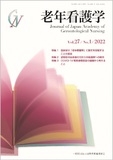Japanese
English
- 販売していません
- Abstract 文献概要
- 参考文献 Reference
抄録
本研究では,体力測定会に参加した地域在住男性高齢者(348人)を対象とし,前期・後期高齢者別の抑うつ傾向と生活機能の関連を明らかにすることを目的とした.前期高齢者を抑うつ傾向群(32人),非抑うつ傾向群(93人)に分類し各測定値を比較した結果,抑うつ傾向群は非抑うつ傾向群に比して,運動時間,眼球注視時間,移動機能,注意機能,手段的日常生活動作(IADL)能力が有意に低値であった.後期高齢者を抑うつ傾向群(58人),非抑うつ傾向群(165人)に分類し各測定値を比較した結果,抑うつ傾向群は非抑うつ傾向群に比して,運動時間,筋肉量,体脂肪率,骨格筋指数,移動機能,IADL能力が有意に低値であった.抑うつ傾向を示す男性高齢者は,年代に共通して運動時間,移動機能,IADL能力を,年代別では,前期高齢者は眼球注視時間,注意機能を,後期高齢者は筋肉量,体脂肪率,骨格筋指数を考慮した保健指導の必要性が示唆された.
The purpose of this study was to clarify the relationship between depressive tendency and life function by early and late stage of aging among male elderly people living in the community (348 persons) who participated in the physical fitness test. The early-stage male elderly were classified into two groups: the depressive tendency group (32 persons) and the non-depressive tendency group (93 persons), and each measurement was compared. The results showed that the depressive group had significantly lower exercise time, eye gaze time, mobility function, attention function, and Instrumental Activities of Daily Living (IADL) ability than the non-depressive group. The late-life elderly were classified into a depressive group (58 persons) and a non-depressive group (165 persons), and each measurement was compared. The results showed that the depressed group had significantly lower exercise time, muscle mass, body fat percentage, skeletal muscle index, mobility function, and IADL ability than the non-depressed group.
The results suggest the need for health guidance that takes into account exercise time, mobility function, and IADL ability in depressed male elderly across age groups, eye-gaze time and attention function in the early elderly, and muscle mass, body fat percentage, and skeletal muscle index in the late elderly.
Copyright © 2022, Japan Academy of Gerontological Nursing All rights reserved.


